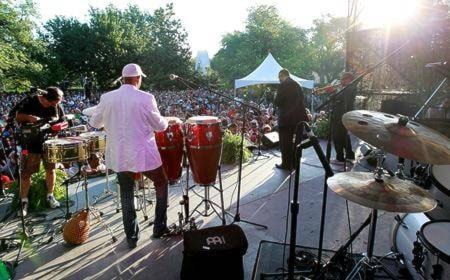NEW ORLEANS — If you just can’t get enough of a performer or group at the New Orleans Jazz and Heritage Festival or want to learn more about him, her or them, you may get lucky at two sideline stages. Call it lagniappe - a New Orleans word for that little bit extra, the 13th doughnut in a baker’s dozen.
Those extras probably won’t be the headliners, such as Saturday’s rock bands Aerosmith and Cage the Elephant or soulful singer-songwriter Anita Baker. But you may see a future headliner — The Lee Boys, a funky gospel steel ensemble headlining the Fais Do Do Stage on Saturday, were on the music heritage stage in 2008. In 2015, it featured blues rock and electric blues singer-songwriter and instrumentalist Delbert McClinton, Saturday’s final act in the Blues Tent.
The Allison Miner Music Heritage Stage, in the grandstand area, generally has five interviews a day with a cross-section of performers from the 11 main stages. The Cultural Exchange Pavilion near the centre of the infield has a different theme each year. This year’s theme is New Orleans’ tricentennial. Saturday’s performers include a group from Congo, a Latin band and a tribute to Louis Armstrong.
Saturday’s interviews feature a Canadian Celtic group called the East Pointers, traditional jazzmen Michael White and Gregg Stafford discussing the early years of jazz in New Orleans, second-generation zydeco musician Curley Taylor, Mardi Gras Indian chief Victor Harris and blues rock guitarist Walter Trout.
And since 1989 - the stage’s second year - those interviews have all been recorded and digitized.
So even though bluesman James “Son Ford” Thomas of Leland, Mississippi, died in 1993, researchers can still hear him sing “I want you to love me, baby. I don’t care how it makes me feel” and tell interviewer Walter Liniger in 1989 that country musicians “play the same sound, the same different sound and make it match. That’s all they do.”
“What I think is important is to try and represent pretty much every genre that you can hear at the bigger stages,” said heritage stage co-ordinator Ben Sandmel. That’s not possible in one day, but it is over two long weekends.
“I also put a lot of thought to matching interviewees to interviewers - make sure they know the music, make sure I hire people who will come in well prepared and help put the music in context,” Sandmel said.
The Cultural Exchange Pavilion near the infield’s centre has a different theme each year: The New Orleans Center for the Creative Arts in 2015, Belize in 2016, Cuba last year, and New Orleans’ tricentennial this year.
“The goal of the pavilion is to highlight some of the cultural ancestors of New Orleans and make ties with the rest of the world,” co-ordinator Valérie Guillet said.
Saturday’s representatives from the wide variety of cultures that contributed to New Orleans are local Latin band Julio y Cesar; Kermit Ruffins’ commissioned tribute to trumpeter Louis Armstrong; Jupiter & Okwess, from the Republic of Congo; the East Pointers again, and Leyla McCalla, a Haitian-American singer who lists much of the city’s musical gumbo as among styles that have influenced her.
This year’s displays include a timeline of New Orleans history and four altars honouring different people, traditions and groups. An elaborate display of decorative cabreads, pastries and other foods recreates the annual tradition of honouring St. Joseph, patron saint of Sicily, on March 19.
The Hispanic community that has grown immensely since Hurricane Katrina in 2005 is honoured with a Day of the Dead altar. A Marie Laveau altar marks vodou and other Haitian influences. The fourth altar honours Jean San Malo, who led villages of escaped slaves known as maroons outside New Orleans during Spanish colonial days.
